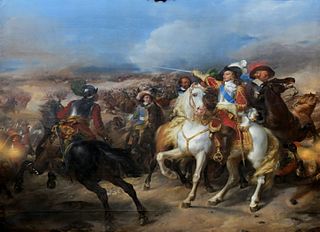
The Battle of Lens was a French victory under Louis II de Bourbon, Prince de Condé against the Spanish army under Archduke Leopold Wilhelm in the Thirty Years' War (1618–1648). It was the last major battle of the war and a French victory. The battle cemented the reputation of Condé as one of the greatest generals of his age.

The Second Battle of Breitenfeld, also known as the First Battle of Leipzig, took place during the Thirty Years' War on 2 November 1642 at Breitenfeld, north-east of Leipzig in Germany. A Swedish Army commanded by Lennart Torstensson decisively defeated an Imperial Army under Archduke Leopold Wilhelm of Austria and his deputy Ottavio Piccolomini.

Ottavio Piccolomini, 1st Duke of Amalfi was an Italian nobleman whose military career included service as a Spanish general and then as a field marshal of the Holy Roman Empire.

Cardinal-Infante Ferdinand was a Spanish and Portuguese prince, Governor of the Spanish Netherlands, Cardinal of the Holy Catholic Church, Archduke of Austria, Archbishop of Toledo (1619–41), and a general during the Thirty Years' War, the Eighty Years' War, and the Franco-Spanish War. He is commonly considered the last great commander and strategist of the Spanish Empire, whose premature death in a decisive moment helped bring the end of Spain's hegemony in Europe. He is as well, one of few generals to be undefeated on the battlefield.

Isaac Manasses de Pas, Marquis de Feuquieres was a French soldier.

The Battle of Honnecourt took place on 26 May 1642, during the 1635 to 1659 Franco-Spanish War. A Spanish army led by Francisco de Melo defeated and largely destroyed a French force under the Comte de Guiche.

The Battle of Kallo was a major field battle fought from 20 to 21 June 1638 in and around the forts of Kallo and Verrebroek, located on the left bank of the Scheldt river, near Antwerp, during the second phase of the Eighty Years' War. Following the symbolic recovery of Breda during the 1637 campaign, the Dutch Republic agreed with the French Crown, with whom it had allied in 1635, to besiege a major city in the Spanish Netherlands during the 1638 campaign. The commander of the Dutch States Army, Frederick Henry of Orange, planned an approach over Antwerp from the two sides of the Scheldt. Count William of Nassau-Siegen was entrusted to land in the Spanish-controlled Waasland region, west of Antwerp, to seize the forts of Kallo and Verrebroek, along with several other key fortifications, to invest Antwerp from the west. In the meantime, Frederick Henry would advance on the opposite bank to complete the blockade of the city while the armies of France invaded the Spanish Netherlands from the south to oblige the Spanish Army of Flanders to divide its forces.
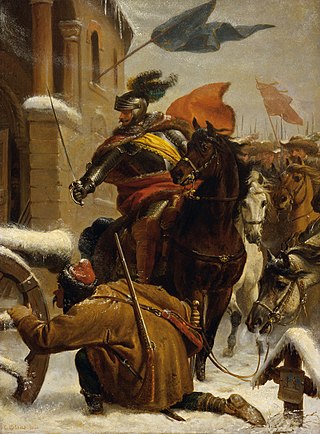
The Battle of Tuttlingen was fought in Tuttlingen on 24 November 1643 between the French army in Germany led by Marshal Josias Rantzau, composed of French soldiers and the so called Weimarans or Bernhardines, German troops once in service of Bernard of Saxe-Weimar. They were defeated by the forces of the Holy Roman Empire, Bavaria and Spain led by Franz von Mercy. Technically, Mercy led a military force composed of his Bavarian army, supported by Imperial, Spanish, and Lorrainer troops. The French army was wiped out in a surprise attack in heavy snowfall along with French strategic gains since 1638. The French court suppressed the defeat and it remains largely unknown today, even among historians of the war.

The siege of Luxembourg was a siege by France of the Habsburg-held Fortress of Luxembourg that lasted from 1794 until 7 June 1795, during the French Revolutionary Wars. Although the French army failed to breach the walls of the city, which were renowned as amongst the best in the world, the fortress was forced to surrender after more than seven months.

The Battle of La Marfée, also known as the Battle of Sedan, took place on 6 July 1641, during the 1635 to 1659 Franco-Spanish War, a related conflict of the Thirty Years War.
The Battle of Chemnitz took place near the town of Chemnitz, in Electorate of Saxony, during the Thirty Years' War. Swedish forces under Johan Banér inflicted a crushing defeat on Rodolfo Giovanni Marazzino who commanded the Saxons and an Imperial detachment under Johann Christoph von Puchheim who was captured by the Swedes.

The Battle of Les Avins took place on 20 May 1635, outside the town of Les Avins, near Huy in modern Belgium, then part of the Bishopric of Liège. It was the first major engagement of the 1635 to 1659 Franco-Spanish War, a connected conflict of the Thirty Years' War.

The siege of Leuven was an important siege in the Thirty Years' War in which a Franco-Dutch army under Frederick Henry of Orange and the French Marshals Urbain de Maillé-Brezé and Gaspard III de Coligny, who had invaded the Spanish Netherlands from two sides, laid siege to the city of Leuven, defended by a force of 4,000 comprising local citizen and student militias with Walloons, Germans, Spanish and Irish of the Army of Flanders under Anthonie Schetz, Baron of Grobbendonck. Poor organization and logistics and the spread of sickness among the French, along with the appearance of an Imperial-Spanish relief army of 11,000 under Cardinal-Infante Ferdinand and Ottavio Piccolomini, forced the invading army to lift the siege. This failure allowed the Spanish forces to take the initiative and soon the invaders were forced into a headlong retreat.
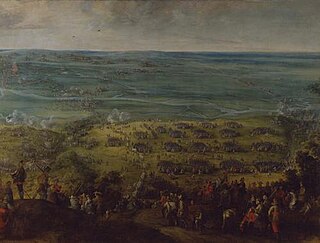
The Crossing of the Somme took place on 5 August 1636 during the Thirty Years' War and the Franco-Spanish War when units of the Spanish Army of Flanders and the Imperial Army under Thomas Francis, Prince of Carignano, lieutenant of the Cardinal-Infante Ferdinand of Austria, crossed the Somme river near Bray-sur-Somme during its offensive in French territory. Despite the fierce resistance of the French army led by Louis de Bourbon, Count of Soissons, the allied troops successfully crossed the river and drove off the French troops along the Oise river, proceeding over the following weeks to invest the important fortress of Corbie, located two leagues upriver of Amiens, which caused a spread of panic among the population of Paris.
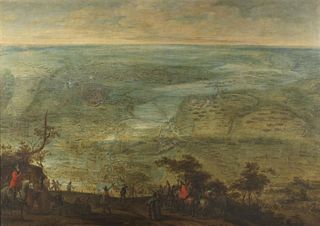
The siege of Saint-Omer was a siege in the Thirty Years' War in which a French army under Gaspard III de Coligny, Maréchal de Châtillon, laid siege to the Flemish city of Saint-Omer, defended by a small garrison in command of Lancelot II Schetz, count of Grobbendonck. Despite several initial successes in the capture of the minor forts around Saint-Omer, on the night of 8/9 June a Spanish relief army under Thomas Francis, Prince of Carignano, surprised Châtillon's troops and established a small fort in the middle of the French lines. An entire army corps under Maréchal de La Force was ordered to move towards Saint-Omer to support Châtillon siege, but on 12 July a further Imperial-Spanish force commanded by Ottavio Piccolomini entered Saint-Omer, resolving the French marshals to withdraw.

The siege of Venlo was an important siege in the Eighty Years' War that lasted from 20 to 25 August 1637. The Cardinal-Infante Ferdinand of Austria, Governor of the Spanish Netherlands, retook the city of Venlo from the United Provinces, which had taken control of it in 1632 during the offensive of Frederick Henry, Prince of Orange against Maastricht. The capture of Venlo and Roermond, which was surrendered to the Cardinal-Infante a week later, effectively cut Maastricht from the Dutch Republic, thus preventing further attacks on the Spanish Netherlands from the east. In the southern front Ferdinand lost the towns of La Capelle, Landrecies, and Damvillers to the French, but then he forced them to retreat south of Maubeuge.

In the siege of Lérida from 29 April to 13 May 1810, an Imperial French army under Louis Gabriel Suchet besieged a Spanish garrison led by Major General García Conde. On 13 May, García Conde surrendered with his 7,000 surviving soldiers. Lleida (Lérida) is a city in the western part of Catalonia. Margalef is located about 10 kilometres (6 mi) southeast of Lérida. The siege occurred during the Peninsular War, part of the Napoleonic Wars.

The Battle of Kempen, also known as Battle of the Kempen Heights, or Battle of Hückelsmay, took place on 17 January 1642 during the Thirty Years' War, outside Kempen, now part of North Rhine-Westphalia. A combined Franco-Hessian army, led by de Guébriant and von Eberstein respectively, defeated an Imperial force under General de Lamboy.
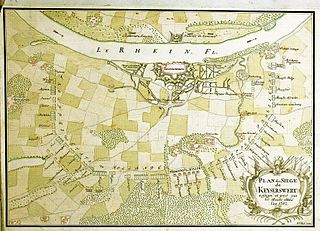
The siege of Kaiserswerth, was a siege of the War of the Spanish Succession. Prussian and Dutch troops numbering 38,000 men and 215 artillery pieces and mortars under the command of Imperial Field Marshal Walrad, Prince of Nassau-Usingen, besieged and captured the small French fortress on the Lower Rhine, which the French had occupied without resistance the previous year. The Dutch regarded the capture of this fortification as more important than an advance into the French-held Spanish Netherlands.

The Siege of Corbie took place from the 7th to the 15th of August, 1636 during the Thirty Years' War and the Franco-Spanish War (1635–59) where a Spanish army under Cardinal-Infante Ferdinand and his lieutenant Prince of Carignano successfully capture the important French fortress of Corbie. The siege would only last a little over a week with the fortress eventually surrendering after 8 days on the 15th of August. This important siege battle is part of the Crossing of the Somme campaign led by the Cardinal-Infante and caused an important event to happen after the siege with the French royal family fleeing Paris in fear of the Spanish tercios and the Cardinal-Infante's campaign, which was thought to have been aimed towards the French capital.



















